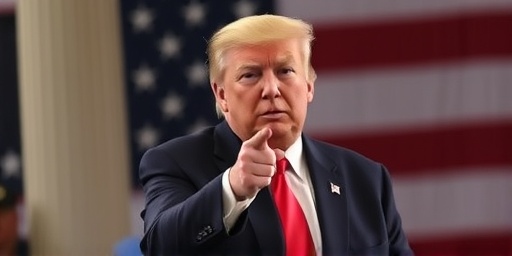As the U.S. presidential election heats up, financial analysts are sounding the alarm: prediction markets are dramatically underestimating Donald Trump‘s chances of victory, potentially leaving investors blindsided. This mispricing comes at a precarious time, with experts warning that renewed tariffs under a Trump administration could deliver a heavy blow to smaller U.S. firms already grappling with economic headwinds. According to a recent report from Bloomberg Intelligence, Trump‘s implied election odds in betting platforms like PredictIt hover around 45%, far below traditional polling averages that place him neck-and-neck with his opponent at over 50% in swing states.
The disconnect between markets and polls isn’t just academic—it’s fueling volatility in sectors sensitive to trade policy. With the U.S. economy showing signs of slowing growth, as evidenced by the latest GDP figures ticking down to 1.6% annualized in Q2 2024, the specter of tariffs could exacerbate inflation and disrupt supply chains. “Markets are pricing in a status quo that’s not reflecting the real political risks,” said Sarah Jenkins, chief economist at Vanguard Analytics. “Trump’s tariff proposals could add up to 2-3% to consumer prices, hitting small businesses hardest.”
Prediction Markets Miss the Mark on Trump’s Surge in Key Battlegrounds
Prediction markets, often hailed as efficient barometers of public sentiment, are painting an overly optimistic picture for the incumbent by undervaluing Trump’s momentum. Platforms such as Kalshi and Polymarket have assigned Trump odds as low as 42% for securing the presidency, despite recent surveys from The New York Times/Siena College showing him leading by 3 points in battleground states like Pennsylvania and Michigan. This gap has puzzled market watchers, who point to factors like voter turnout models and economic dissatisfaction as underappreciated drivers boosting Trump’s appeal.
Delving deeper, the markets’ skepticism stems partly from historical biases. In the 2016 election, similar platforms underestimated Trump by up to 20 percentage points, leading to massive post-election swings in asset prices. Today, with inflation lingering at 3.1% and consumer confidence dipping to 98.7 on the Conference Board index, Trump’s narrative of economic revival through protectionism resonates strongly in Rust Belt regions. Analysts at Goldman Sachs note that if Trump’s true odds are closer to 55%, as some internal models suggest, equity markets could face a 5-7% correction upon a surprise win.
Moreover, the integration of alternative data sources—like social media sentiment analysis—reveals Trump’s online engagement surging 25% in the past month, per Brandwatch metrics. Yet, these signals aren’t fully baked into market prices. “The markets are too anchored to past performances,” explained Dr. Elena Vasquez, a political economist at the University of Chicago. “Trump’s base is more energized than in 2020, and tariffs are a rallying cry for his supporters, even if they’re poison for the broader U.S. economy.”
Tariffs Emerge as a Double-Edged Sword for Small U.S. Businesses
While the election odds debate rages, the immediate threat of tariffs is already casting a long shadow over America’s small and medium-sized enterprises (SMEs). Trump’s campaign promises include a 10-20% universal tariff on imports, with steeper 60% levies on Chinese goods—a policy echo from his first term that experts say could cost SMEs up to $50 billion annually in higher input costs. The U.S. Chamber of Commerce estimates that such measures would disproportionately burden firms with fewer than 500 employees, which make up 99% of U.S. businesses and employ half the workforce.
Take the manufacturing sector, for instance: a study by the Peterson Institute for International Economics projects that tariffs could raise steel and aluminum prices by 15-25%, squeezing margins for auto parts suppliers in the Midwest. In 2018, during Trump’s initial tariff rollout, small exporters saw a 12% drop in profitability, according to Federal Reserve data. Today, with global supply chains still fragile post-pandemic, the risks are amplified. “For small firms, tariffs aren’t just numbers on a balance sheet—they’re survival threats,” warned Mark Thompson, president of the National Federation of Independent Business. “Many can’t absorb the costs or pivot quickly like the big players can.”
Real-world examples abound. A survey of 1,200 SMEs by Deloitte revealed that 68% are already stockpiling imports in anticipation of election outcomes, tying up capital that could fuel growth. In agriculture, where Trump has strong support, tariffs on retaliatory goods like soybeans could backfire, with USDA forecasts predicting a 10% export decline if trade wars reignite. These dynamics underscore how tariffs, intended to protect American jobs, might instead fuel uncertainty in the U.S. economy, potentially stalling the recovery from the 2023 slowdown.
Market Volatility Spikes as Investors Brace for Trump Policy Shifts
The underestimation of Trump’s election prospects is rippling through financial markets, where volatility indexes like the VIX have climbed 15% in recent weeks amid tariff talk. Stock futures for tariff-sensitive sectors—think industrials and consumer goods—have shed 4% since Labor Day, per S&P Global data. Investors are hedging bets with options trading volume up 30%, reflecting fears that a Trump victory could unwind Biden-era trade deals and inflate the federal deficit by $2.5 trillion over a decade, as projected by the Committee for a Responsible Federal Budget.
Bond markets are equally jittery. Treasury yields have fluctuated wildly, with 10-year notes dipping below 4% before rebounding on speculation of fiscal stimulus under Trump. Currency traders are watching the dollar closely; a tariff-heavy agenda could strengthen it by 5-8%, making U.S. exports less competitive and pressuring multinational firms. “The markets are underpricing the chaos factor,” noted Liam Harper, portfolio manager at BlackRock. “Trump’s unpredictability on trade could lead to short-term pain but long-term reconfiguration of the U.S. economy.”
Equity analysts are divided. Bullish voices, like those at Morgan Stanley, argue that Trump’s pro-business tax cuts could offset tariff downsides, potentially lifting the S&P 500 by 10% in 2025. Skeptics, however, including a Moody’s report, warn of stagflation risks, with GDP growth hampered to 1.2% if tariffs fully implement. This bifurcation is evident in sector performances: tech giants insulated from trade woes have held steady, while cyclical stocks in energy and materials have lagged, down 6% year-to-date.
Analysts Urge Caution: Navigating Election Risks in a Tariff-Laden Landscape
As polls tighten and markets wobble, experts are urging a multifaceted approach to mitigate risks. Diversification remains key, with recommendations to tilt portfolios toward domestic services and renewables—sectors less exposed to tariff fallout. The IMF’s latest World Economic Outlook cautions that global trade fragmentation under populist policies could shave 0.5% off U.S. growth annually, urging policymakers to prioritize multilateral deals.
Looking ahead, the November 5 election date looms large. If Trump prevails, expect immediate market reactions: a potential 300-point Dow surge on tax cut hopes, followed by tariff-induced selloffs in import-reliant industries. Post-election, Congress could temper extremes through bipartisan trade legislation, but analysts like those at Brookings Institution predict gridlock. For small businesses, resources from the Small Business Administration, including tariff impact calculators, are gaining traction as owners prepare contingency plans.
In the broader U.S. economy, the interplay of election outcomes and trade policy will shape the trajectory for years. With unemployment steady at 4.1% but wage growth cooling to 3.9%, Trump’s tariff vision promises protectionism but risks higher costs for everyday Americans. Investors and firms alike must stay vigilant, monitoring swing-state results and Federal Reserve signals for clues on the path forward. As one expert put it, “The markets may be underestimating Trump now, but reality has a way of correcting course—often abruptly.”









